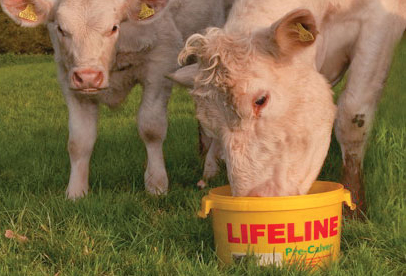As concentrate prices hold strong and livestock farmers push stock harder on homegrown feeds, nutritional shortfalls in forage needs to be addressed for breeding stock, says Dr Alison Bond, nutritionist for Rumenco.
“Throughout the winter feeding period, the key ration ingredient will almost always be some kind of forage, whether it be grazing, silage or hay,” explains Dr Bond.
Typically the most cost effective feed source, forage has nutritional gaps that need to be filled for gestating livestock with variations in energy, protein and essential trace element content.
“This is especially important for the final weeks leading up to lambing and calving when the majority of foetal development is taking place and nutrients are starting to partition towards colostrum production,” says Dr Bond. “The nutrients available will have a direct impact on the short and long-term performance of livestock giving birth and their offspring. It is essential these animals receive the right nutrition during this time.”
During this period of high nutritional demand, Lifeline Pre-Calver and Lifeline Lamb and Ewe supplements are ideal for delivering minerals, vitamins and trace elements, including good levels of selenium and vitamin E, Lifeline supplements also support animal health pre and postpartum.
To meet added nutritional demands of late gestation ewes, Lifeline Lamb and Ewe provides high energy and digestible undegradable protein. The supplement’s blend of nutritional boosters, including lactose, mannan-oligosaccharides and beta-glucans, supports immune function and enhance colostrum immunoglobulin content.
“The extra addition of minerals, vitamins and trace elements found in both cattle and sheep supplements, and the additional energy and protein in Lifeline Lamb and Ewe, will help to improve health, fertility, production and overall animal performance,” explains Dr Bond. “This goes a long way towards stretching homegrown forage stocks, which in return helps cut down on bought-in concentrate requirements.”
Sheep nutritional requirements
For sheep, 75 percent of foetal growth takes place in the final two months of pregnancy with under feeding resulting in reduced udder weight, impaired mammary and colostrum development, dystocia and consequences to mothering ability. Overfeeding carries many of these same consequences, also increasing the risk of prolapse, delayed onset lactation and lamb vigour.
In the transition from mid to late pregnancy, scanning the flock and sorting based on litter size will allow farmers to better meet individual nutritional requirements and again six weeks before lambing.
“It is recommended that metabolisable energy (ME) is increased by 0.24MJ for each 10kg of bodyweight. The number of lambs carried and the proximity to lambing also impacts ME requirements. These varying factors make it essential to sort ewes based on their energy needs,” explains Dr Bond. “For example, a 70kg ewe carrying a single, three weeks pre-lambing has a ME requirement of 12.6 MJ/day, which increases to 16.7MJ/day with triplets – that’s a pretty substantial difference in energy demand.”
Suckler cow nutritional requirements
For suckler herds, the main challenge is to prevent cows from becoming too fat due to overfeeding during the dry period. Maintenance needs are determined by cow weight and the level of energy in forage.
“Spring calving suckler cows that don’t need to lose or gain any condition will have a requirement over the winter of around 80 MJ/day. Assuming forage is at 25 percent DM, a 700kg suckler cow will require 35.5kg of forage to fulfil this energy requirement,” says Dr Bond. “If the forage is higher in energy at 11.5 ME, then the forage requirement is around 8kg less. That difference could mean animals put an extra 0.5kg/day on. This is fine if they need it, but if they are already being housed in good condition, then this gain could be bad for them and result in issues around calving time.”
Understanding forage quality
With underfeeding and overfeeding cattle and sheep being balanced around forage quality, Dr Bond advices farmers to have forage samples analyzed to get a baseline understanding of its nutritional value.
“The 2021 grazing season has been very stop-start with a rotation of cold, damp periods followed by warm spells. This has led to an average grass season with quality rapidly declining into the autumn as expected,” says Dr Bond. “This weather pattern led to an extended and inconsistent silage season for many parts of the country, with significant differences in quality between cuts.”
Industry data shows this autumn’s grass to have good levels of rumen degradable protein, while silage taken at the start of the season to have low crude protein and high NDF (neutral detergent fibre) indicating it is stemmy and harder to digest. Data from silage analysis lab Thomas and Joseph have found samples from across the UK to have a decrease in most trace elements with lower levels in macro-minerals – a result of the cold, wet growing conditions in the early season followed by rapid growth.
“The birds-eye view of forage quality across the UK has highlighted a lot of variations in quality and nutritional values. While results will vary from farm to farm due to weather and management differences, these findings really demonstrate the importance of understanding forage available this season so strategic management decisions can be made to support both stock performance and farm profitability,” concludes Dr Bond.


